TennisOne Lessons The Cycling Model Doug King In my previous two articles I have discussed rhythm and timing on the strokes, arguably the most elusive aspects of the tennis swing. I would like to further develop these concepts and in doing so introduce an analogy that may provide a helpful model by which to approach stroking. Analogies and Metaphors Analogies and metaphors, although rarely precise, can still be very useful tools in analyzing phenomena. They help us learn to explore territory that is unfamiliar by giving us a basis of reference. In the following analogy that I present, the intent is not to create a literal translation of the tennis stroke but to provide a comparison that may help to interpret certain feelings and perceptions of tennis stroking in a new way.
With this in mind, I would suggest that an interesting analogy to tennis stroking is riding a bicycle. I believe that the way that the body, the racquet, and the ball work in a tennis stroke is quite similar to how the body, the chain, and the gears, work in riding a bicycle. I think that by using a bicycle riding analogy we can achieve a better framework by which to develop effective stroking habits. It is especially useful since it is an activity that almost everyone has experience with and something we consider simple and “natural”. Riding a Bike and Stroking a Ball First let me develop the comparison. Imagine you are riding a multi-speed (multi-gear) bicycle. The way that power is generated in the bike riding process is by first creating a connection between the chain and the gear and then once that connection is established then the legs thrust on to the pedals to release power. I think this is a good way to imagine hitting a tennis ball – that is, the racquet and the ball link together and then the body (primarily arm instead of leg) thrusts to create power. Now this may seem rather obvious but as we look at it a little closer I think it addresses some of the common misperceptions and common swing errors that plague many players. Power and Speed vs. Alignment When we ride a bicycle we never talk about “chain speed.” The chain is basically passive. We don’t “swing” the chain at the gear. We don’t try to get the chain to “hit” the gear. The chain is guided on a “track” and the object is to get the chain and the gear to “mesh,” to link up properly. Once that linkage occurs then “work” can be performed. Power is always concentrated and considered as a thrust from the body. That power is primarily released through a bending and straightening of the legs. I think this is a useful way of approaching the tennis stroke equation; how the racquet should interact with the ball and where power should be generated from.
Chain and gear link up, the legs thrust and away you go!
Far too often I see players over-swinging the racquet rather than getting the racquet to properly “track” through the stroke and to properly “align” onto the ball and target. Far too often I see players letting the racquet “swing” the arm instead of the opposite, which is, letting the racquet “respond’ to the thrust of the arm. How often do we think of and speak of “racquet speed?” I think it is often counterproductive to think in terms of racquet speed because ultimately what is necessary is to create connection or alignment between the ball, the racquet, and the target and to concentrate the powering of the stroke action to more of a thrust from the body. When you ride a bicycle you have an innate understanding that the chain must link up with the gear before you can even consider going anywhere. So that becomes the primary objective between the chain and the gear – linkage – and then the secondary objective is to pedal hard. Now don’t get me wrong, speed in the racquet is a critical aspect of power but it is in, what I consider, the overly direct association of speed and the racquet head that I find objection. The more we can identify the speed as coming from an “interior” source (i.e. the body), the more stable the stroke will become. The more we can reduce the instability in the racquet head and the more I can execute precise, controlled alignment of the racquet the better.
No matter how fast the swing goes, no matter how fast that racquet is traveling, I think that it is always better to feel that it is not so much the racquet that is swinging as it is the body is doing something and the racquet is simply getting aligned to the ball and aiming at the target. A fast racquet really should come from light feet, quick hips, and relaxed hands. Neutral Swinging and Power Swinging There are many other correlations that we can glean from the bicycle analogy. Another is “timing.” Think of stroking a tennis ball as relating to the act of switching gears. When you are switching gears on a bike there is still pedaling that occurs in-between gear changes even though there is not yet any linkage between the gears and the chain. Still, this pedaling is necessary to assist in the engaging of the chain and the gears. You might call this “neutral pedaling.”
At the moment engagement occurs then the “engaging pedaling” converts into “power pedaling” in a relatively smooth transition. The “neutral pedaling” is very different in nature and function then the “power pedaling.” The neutral pedaling is very smooth and fluid while the power pedaling is forceful and designed to move things. In a similar way I think it is useful to think of the part of the tennis swing that occurs prior to the contact event as smooth and fluid. Like in cycling it is basically designed to get the racquet and the ball and the target to link up. Once this linkage occurs then the swing turns into power swinging. This power swinging occurs through the moments of engagement between the racquet and the ball (what we refer to as the “contact zone”). In the case of the tennis swing, this is a very brief time, indeed. Think of the rhythm of continuously stroking a tennis ball as that of constantly changing gears and having only a brief moment of time in which the gears are actually engaged, the same amount of time that you are with the ball. Every time the ball approaches the racquet you must time the thrust of the body to occur at the moment when the ball and the racquet link up. Then the moment the ball leaves the strings you are back into neutral, then you go into “stroke idle” while you await the contact of the ball from your opponent, at which moment you start your neutral swing and so on. When we apply forceful body action without first achieving “engagement” then we are essentially “spinning our gears” - effort is wasted and no power is achieved.
Turning the Gears Another aspect of the bike riding analogy that translates to the tennis swing is the way that the chain turns the gear. I think this is a useful way to approach the concept of spin in tennis and suggests that there are beneficial aspects of turning or spinning the ball that go beyond the manipulation of trajectory (which is critical in itself). It may be that this circular engagement has an inherent efficiency of power transfer but it is something that is very clearly demonstrated by all top players. The racquet should engage and turn the ball in a “gear like” fashion. The varieties in spin and swing tempo can also be interpreted as different gears in a car or bicycle. When you shift to a higher gear you can achieve more speed but this must also translate to faster turning of the ball. So in the case of a tennis swing, the faster you swing the racquet the faster you must turn the ball, or the aster you must come off of the ball. This doesn’t necessarily mean more power. You can swing slower and turn the ball slower and actually create more power. In either case you are still working on the same “gear” principle. Putting It into Play To convert this analogy into actual play technique requires practice and a few key points to focus on. First, try to keep the racquet more passive throughout the swing. Don’t try to get the racquet to swing back in the backswing or to swing out on the follow through but instead try to get the racquet to smoothly “track” into the ball (think of “neutral pedaling). Remember the object is to get the racquet to line up to the ball and the target, and to establish “linkage” or connection. Once you sense connection with the ball visualize a turning of the ball (like gears meshing and turning) while the racquet stays aligned to the target even through the turning of the ball.
For many shots I prefer to think that the arm and racquet “collapse” into the ball rather than swing at the ball. This allows the arm to move in a fluid way and lets the racquet become “passive’ to the arm and body. This assists also in getting the racquet to “connect” better with the ball and avoids over-swinging. If you watch good players you will notice that what they execute is a perfectly timed “collapse” of the wrist into the ball (more on this later). Secondly, learn to use the body at the moment of contact to produce the push and turn of the ball. Instead of trying to get the racquet to do the swinging and hitting, try to get the sense of “hitting” into the body and arm. Just like on the bike you don’t try to get the chain to go fast until it has engaged with the gear and when that moment of engagement between the gear and the chain does occur it is a release of energy coming from the body that moves everything. Try to create the same dynamic with the tennis stroke. In your practice sessions try to concentrate on what the body does in the moments that the racquet comes into contact with the ball rather than simply feel that the racquet is swinging at the ball. You may identify flexion in the legs, arms, back, or rotation from the hips, pushing and pulling of the arm, push and rotation from the balls of the feet – any number of actions depending on the situation and the desired result. Once the body assumes more involvement in the powering of the ball this will tend to keep some of the extra swinging out of the racquet head. Try to develop more of a sense of the racquet actually “not swinging” through contact and increase the sense of alignment both to the ball and the target of the racquet face. Third, on the finish of the stroke, try to get a part of the body to “finish” somewhere rather than trying to get the racquet to finish somewhere. For example, concentrate on lifting the shoulder on contact and finish with the shoulder touching the chin. Don’t focus on where the racquet ends up – in fact, try to get the racquet to simply “disappear” on the ball at contact so that you don’t feel it swinging at all. Remember that the job of the hands is not to swing the racquet at the ball but to get the racquet to properly align with the ball and target and to “hold” the ball. The power and speed will come from the body and arm.
Practice Drills The Chair A great way to develop more body into the stroke is by using the chair technique. When you sit and stand in a chair you are creating huge flexes throughout the body (ankles, knees, waist) that gather and release a great deal of energy. I like to use an office chair that also swivels to add an element of rotation into the equation. The chair provides an automatic platform of balance and a controlled space of movement (like a cylinder of vertical space). First just go up and down in the chair to get the feeling of using the legs in the stroke. Then try to time your tennis stroke into the up and down lift so that so you sink into the chair prior to contact and lift just as you contact. Think of the racquet as squaring up on an imaginary ball and target and then simply responding to the movements of the body. After a few practice swings have someone pitch a few balls to you and try to reproduce the stroke movement. Try to get the feeling that you are using your leg lift and shoulder turn to move both the ball and the racquet together. Do this on both forehand and backhand. Experiment with this technique to include sinking down into the chair to hit. This can be a common underspin shift that is used often on volleys but you can occasionally use a down shift even on a topspin shot. Almost any action out of the legs, whether it is straightening or bending is potential power and can be used to drive the ball. The Hoop Roll A good way to develop a sense of keeping the racquet better aligned through contact is to take a hoop (a hula hoop is good) and try to roll it forward with the racquet. The racquet must stay aligned to a target that you are rolling the hoop towards as the racquet lifts up the back of the hoop. This is how one should try to manage the racquet through contact with the tennis ball. A casual swing of the racquet would usually just spin the hoop around with little control. Instead you have to “manage’ the racquet on the hoop, being careful to use the racquet to turn the hoop while keeping the racquet face directed towards the target. The body action provides forward propulsion through other means (turning, shifting extending).
Eventually you will get the sense of how to hold the tip of the racquet back slightly to achieve better alignment of the racquet face to the target, while the arm and body provide forward thrust. This subtle holding back of the tip of the racquet is what I call “negative racquet swing”. Summation Next time you are on a bicycle, every time you switch gears think about your tennis stroke. Feel how you pedal smoothly in neutral trying to get the chain and the gear to engage and then how you drive from the body once you feel that moment of engagement. You aren’t really concerned about trying to get the chain to go fast – certainly not in neutral. You know that power comes from a properly timed thrust from the body. If the body goes fast everything else will follow. In a similar way the racquet works like the chain and the ball is the gear. Remember, keep your power in your seat – don’t get derailed or spin your gears by over-swinging. Keep your hands soft and well lubricated, choose the right gear and make it as simple as riding a bike. Your comments are welcome. Let us know what you think about Doug King's article by emailing us here at TennisOne.
Doug is one of the country's foremost tennis teaching innovators. Founder of Acceleration Tennis, a revolutionary teaching system, King is leading the way in reinterpreting the traditional tennis model. For more information on Acceleration Tennis please email Doug King at dking@meadowood.com. |
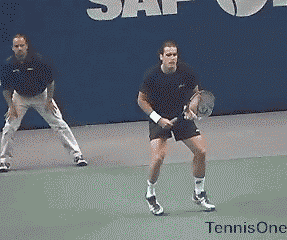
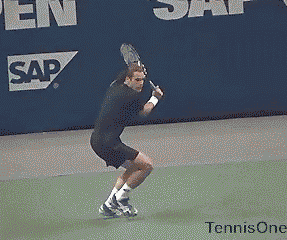
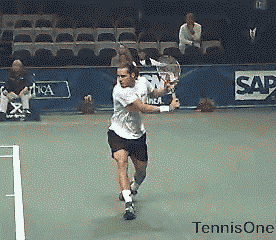
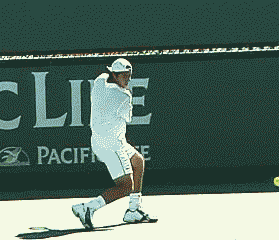
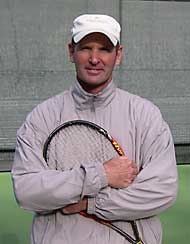
 Doug King studied with legendary tennis coach Tom Stow and was a
former California State Men's Singles Champion
and the former number one men's player of Northern California.
Doug King studied with legendary tennis coach Tom Stow and was a
former California State Men's Singles Champion
and the former number one men's player of Northern California.